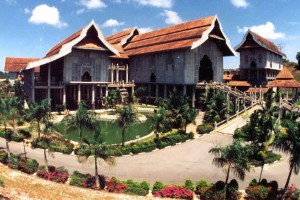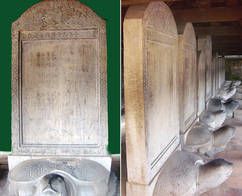posted on
24 Jan 2012
Terengganu State Museum, Malaysia

 The museum was established in the year 1976 under Enactment 1976 Vol. 9 and approved by the state assembly on 28th of December 1976, effective on 1st of November 1977. The history of the museum begins with the discovery of the Terengganu inscription stone in Kampung Buloh, Hulu Terengganu by Syed Hussein Ghulam Al Bukhari in the year 1902. This inscription stone which is the earliest to be found written in Jawi (Malay in Arabic Script) was exhibited at the Raffles Museum, Singapore in 1923. This was to be an iconic artefact for the new museum.
On 3rd of February 1974, a committee was set up to oversee the establishment of the Terengganu State Museum. In the year 1981, a curator have been appointed to lead the State Museum. In 1985, this post was enchanced and converted to the office of Director. In July 1992, the Terengganu inscription stone was returned to state of Terengganu from the Muzium Negara in Kuala Lumpur. In 1994, the museum had its new home in the Terengganu State Museum Complex located on a 27 hectare land in Bukit Kampung Losong, Paloh, Kuala Terengganu. This new museum complex has buildings which are inspired by the architectural design of traditional Malay houses in Terengganu.
The Terengganu State Museum's mission is:
The museum was established in the year 1976 under Enactment 1976 Vol. 9 and approved by the state assembly on 28th of December 1976, effective on 1st of November 1977. The history of the museum begins with the discovery of the Terengganu inscription stone in Kampung Buloh, Hulu Terengganu by Syed Hussein Ghulam Al Bukhari in the year 1902. This inscription stone which is the earliest to be found written in Jawi (Malay in Arabic Script) was exhibited at the Raffles Museum, Singapore in 1923. This was to be an iconic artefact for the new museum.
On 3rd of February 1974, a committee was set up to oversee the establishment of the Terengganu State Museum. In the year 1981, a curator have been appointed to lead the State Museum. In 1985, this post was enchanced and converted to the office of Director. In July 1992, the Terengganu inscription stone was returned to state of Terengganu from the Muzium Negara in Kuala Lumpur. In 1994, the museum had its new home in the Terengganu State Museum Complex located on a 27 hectare land in Bukit Kampung Losong, Paloh, Kuala Terengganu. This new museum complex has buildings which are inspired by the architectural design of traditional Malay houses in Terengganu.
The Terengganu State Museum's mission is:
- To Rescue
- To Conserve
- To Study
- To Display
- To Educate
- To undertake research and studies on some specific areas specially related to the State’s culture and the obtained information disseminated to the general public for knowledge and education, and to inculcate the love for one’s own history and culture.
- To undertake research and studies on the State’s history, and preserve the historical remains present within, while placing the negative historical views in their proper perspectives according to accepted values that are free from external influences. Every level of the community will be encouraged to use the museum facilities for purposes of research and education.
- To undertake research and conservation on the fauna, flora and geological structures that are present in the state.
- As an asset and main destination centre for tourists besides supporting and encouraging the development of the tourism industry of the State, specifically, and Malaysia, generally.
Similar content
posted on
03 Feb 2018
posted on
01 Feb 2012
posted on
10 Mar 2012
posted on
04 Sep 2012
posted on
08 Aug 2013
posted on
15 Nov 2014
